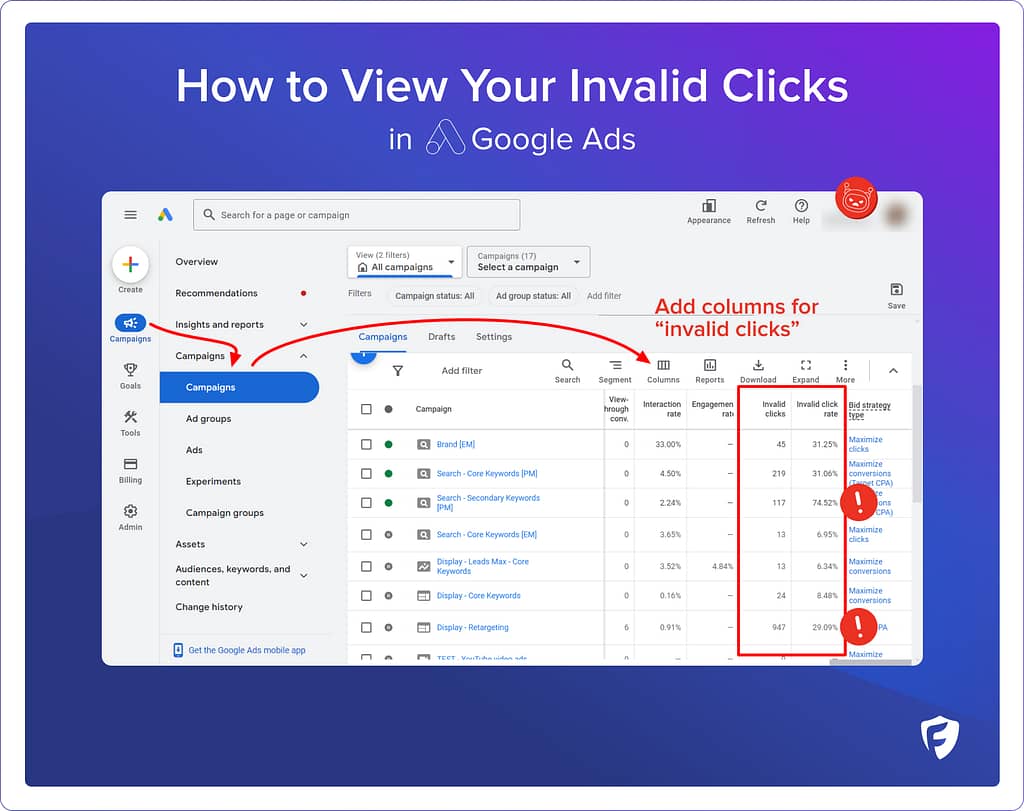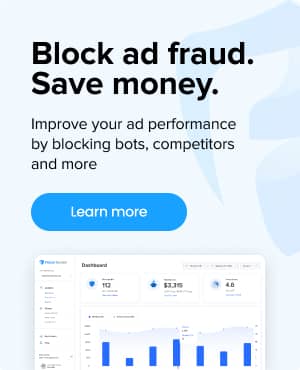What are Invalid Clicks?
Invalid clicks are any form of clicks that does not originate from genuine users with real interest or intent. This includes a wide range of activities, ranging from automated bots and crawlers simulating human interaction, to deceptive practices like pixel stuffing and ad stacking. The common thread across these activities is that they lack any potential to convert into meaningful engagement or sales, rendering them not only ineffective but potentially harmful.
View our report on the average invalid click rates for Google Ads
How to view your Invalid Clicks in Google Ads
You can view the amount of invalid clicks detected by Google Ads in your main reports dashboard. Here’s how:
- Click “Campaigns” – main left nav
- Click “Campaigns” – secondary left nav
- Select “Columns” above the main reports data
- Add “Invalid Clicks” and any related data points
- Select “Save”
Scroll to the right and you’ll see your new columns added along with the data.
Note: Google automatically refunds you for these invalid clicks. Learn more.
The impact of Invalid Clicks on your ad campaigns
Because invalid clicks are so prevalent, it can be hard to truly understand the impact it has on your business. From wasted time and resources, bad data, and more – see some of the most common ways invalid clicks can affect your business:
- Wasted Budget: Your marketing budget can be wasted by clicks and impressions that hold no real value, as they originate from non-human clicks or deceitful practices. A recent Juniper Study on the impact of ad fraud showed that 22% of all digital ad spend was lost to fraud in 2023. This directly affects the campaign’s return on investment (ROI), as the expenditure does not correlate with an increase in genuine customer engagement or sales.
- Skewed Analytics: Invalid clicks can distort your data and performance metrics, such as click-through rates (CTRs) and conversion rates. As the saying goes: “bad data in, bad data out”. Invalid clicks complicates your analysis and makes it harder to create informed decisions, and leads to less effective marketing strategies and potentially misallocation of resources.
- May Harm Your Reputation: As an advertiser, there is a risk to your reputation if you appear on disreputable sites or in contexts that do not align with their brand values. Understand where your ads serve and make sure they are serving on sites and properties that align with your brand values.
Types of Invalid Clicks
There are two main types of clicks from invalid traffic: General Invalid Traffic (GIVT) and Sophisticated Invalid Traffic (SIVT). By classifying them as general or sophisticated, we can better understand and combat invalid clicks more effectively.
1️⃣ General Invalid Traffic (GIVT)
GIVT refers to the “simpler” forms of invalid clicks that can generally be detected with basic filtration processes. A few common examples are listed below:
- Web Bots and Crawlers: Automated programs that index web content for search engines. While essential for search engine operations, their interactions are not indicative of human interest or commercial intent. Learn more about Good Bot vs Bad Bot traffic.
- Analytical Bots and Monitoring Tools: Services that track website performance and availability may generate hits that inflate click statistics without contributing to actual user engagement.
- Known Data Centers: Clicks originating from IP addresses associated with data centers rather than individual human users. Often indicates automated scripts or bots.
2️⃣ Sophisticated Invalid Traffic (SIVT)
SIVT requires more advanced analytical tools or dedicated services to detect, due to its complexity and the deliberate efforts to mimic human behavior. Here are a few examples of SIVT:
- Botnets: These are networks of hijacked computers or devices controlled by malicious actors to generate large volumes of fraudulent traffic. This type of invalid traffic can participate in click fraud, DDoS attacks, and other malicious activities. Learn more about Click Bots.
- Click Farms: Organized groups of individuals or automated systems that manually click on ads or engage with websites to artificially inflate engagement metrics. Often used to commit ad fraud or manipulate social media metrics. Learn more about Click Farms.
- Ad Injection, Adware, Malware: Malicious software that inserts unauthorized ads into web pages or redirects users to other sites. This not only diverts legitimate ad revenue but also compromises user experience and trust.
- Pixel Stuffing and Ad Stacking: Deceptive practices where ads are displayed in a manner that prevents them from being seen by users (e.g., stuffing multiple ads into a single pixel or stacking them on top of one another) while still registering as impressions. Learn more about Pixel Stuffing and Ad Stacking.
Understanding the nuanced landscape of invalid traffic is crucial for implementing effective countermeasures. By recognizing the distinct characteristics and implications of GIVT and SIVT, advertisers and publishers can tailor their strategies to safeguard their digital assets against these pervasive threats.
Common signs of Invalid Clicks
Identifying and mitigating the impact of invalid clicks is an important part of managing your digital marketing campaigns. You can use any tool that analyzes your site traffic (like Google Analytics) to reveal patterns indicative of fraudulent or non-human activity. Below are common methods to detect invalid clicks within your analytics data:
Abnormal Traffic Spikes
Sudden, unexplained increases in website traffic can often be attributed to invalid clicks. This is particularly suspicious when the spikes do not correlate with marketing activities, such as campaigns or promotions. Make sure you examine your traffic sources regularly, and keep a close eye on new sources of traffic (example: a new affiliate or referral channel, or new paid traffic source).
Very High or Very Low Bounce Rates
Invalid clicks, especially from bots, often results in anomalously high or low bounce rates (100% or 0% are often a sign of invalid activity). Bots typically access a single page and then leave, skewing engagement metrics. A sudden rise in bounce rate, especially from new traffic, can signal the presence of invalid clicks.
Short Session Durations / Engagement rates
Similar to high bounce rates, exceedingly short session durations can indicate non-human traffic. Bots or fraudulent visitors usually do not interact with the content meaningfully, leading to session times that are below average or with significantly lower engagement rates.
Discrepancies in Conversion Rates
While high traffic might suggest successful reach, a significant discrepancy between traffic volume and conversion rates could indicate that a large portion of the traffic is invalid. Genuine visitors are more likely to engage with the content or complete desired actions, such as making purchases or signing up for newsletters.
Geographic Anomalies
Invalid traffic might originate from geographic locations that are irrelevant to the targeted market of the campaign. An unusual amount of traffic from countries or regions not aligned with the campaign’s focus could be a red flag.
Unnatural Patterns in Traffic Sources
Monitoring your traffic can reveal patterns indicative of invalid traffic. For example, a disproportionate amount of traffic coming from a single referrer, or direct traffic without a clear source, can suggest manipulation or fraudulent activities.
Inconsistent Device or Browser Data
A significant portion of traffic coming from the same device type, browser version, or operating system, especially when it deviates from known customer profiles, can indicate bot activities. Fraudulent operations often utilize similar devices or software to generate bulk traffic.
Detecting invalid clicks in analytics data requires a combination of technological tools, analytical skills, and ongoing vigilance. By employing these strategies, digital marketers can better safeguard their campaigns against the detrimental effects of non-human and fraudulent traffic, ensuring more accurate data analysis and improved campaign performance.
Ways to avoid Invalid Clicks
Now that we know what invalid clicks looks like, what can we do to minimize or block them? There is a mix of basic and advanced strategies that can significantly reduce exposure to fraudulent activities and non-human interactions:
Use Fraud Blocker
Our software helps you eliminate invalid clicks from your ad campaigns to save you money and improve your performance. Learn more.
Use IP Address Exclusions
To start, you can focus on excluding traffic from known sources of invalid behavior. This includes the IP addresses of known data centers not associated with human activity, or previously identified sources of fraudulent traffic.
Use CAPTCHA
Using CAPTCHA verifications on forms and during significant interactions helps to make sure actions are being performed by humans, not bots. This method can be effective in reducing spam and automated form submissions. Note: these don’t work great.
Use Honeypots
A honeypot is a technique designed to attract and trap form bots and other types of web bots. Learn more about Honeypots.
Try Ad Verification Services
Ad verification services provide an additional layer of security by verifying that ads are seen by real people in the intended locations and contexts.
Leveraging Behavior Analysis
Advanced behavior analysis tools can usually differentiate between human and non-human traffic patterns. By analyzing mouse movements, click patterns, and navigation paths, these tools offer insights into the legitimacy of traffic sources.
Work with Reputable Partners
Working with reputable advertising networks and partners can help minimize exposure to invalid traffic. Nothing is perfect, but established networks have robust mechanisms in place to detect and prevent fraud.
Minimizing invalid traffic requires a multi-faceted approach that combines technology, vigilance, and collaboration. By implementing these strategies, you can protect your digital marketing investments. The end goal is genuine user engagement, accurate analytics, and informed decision-making.
Frequently asked questions
Can I get a refund for invalid clicks from Google Ads?
Yes! See our full guide: How to get a refund for invalid clicks from Google Ads
Is it possible to eliminate invalid clicks completely?
While it’s challenging to eliminate invalid clicks entirely, adopting best practices and leveraging advanced detection tools can significantly reduce its impact on your campaigns.
Who is responsible for combating invalid clicks?
Combating invalid clicks is a collective responsibility that involves advertisers, publishers, ad networks, and technology providers working together to enhance transparency and security in the digital advertising ecosystem.
Related glossary terms:






